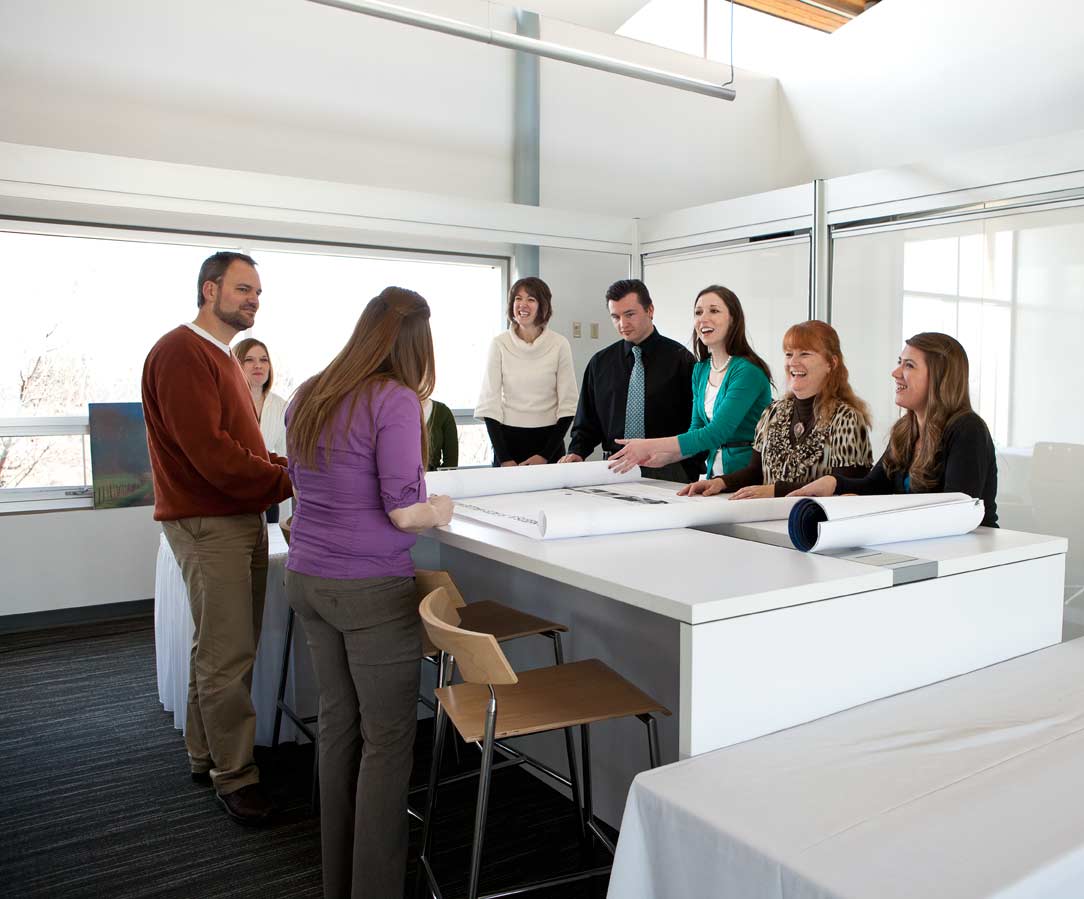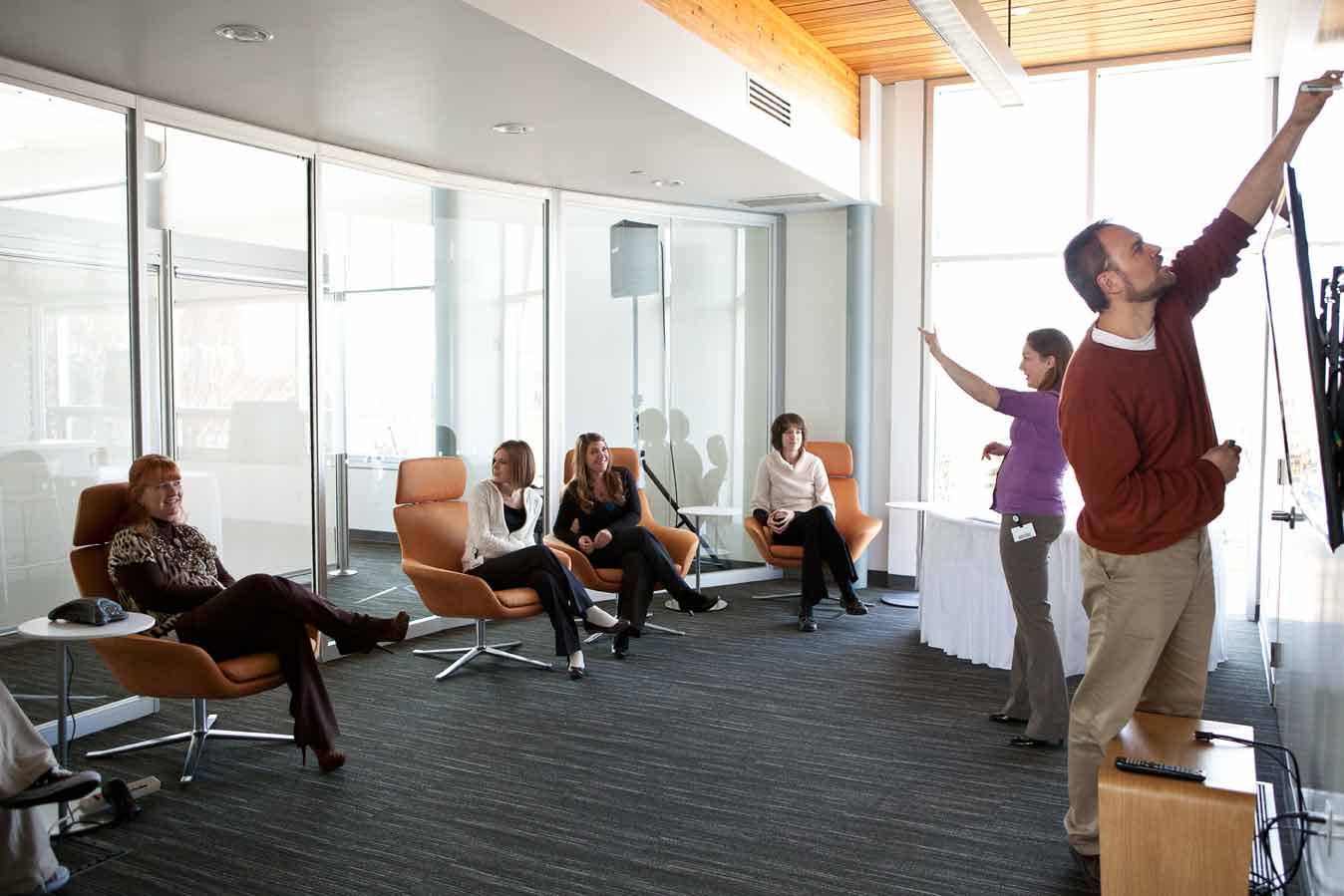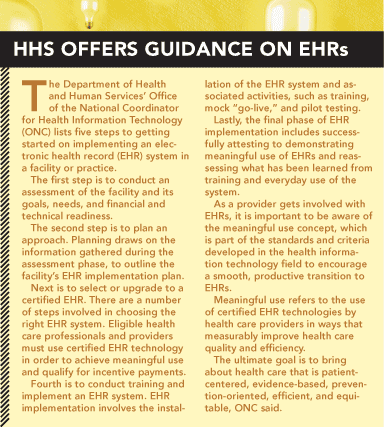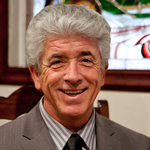Of the many reasons for the long term care sector to modernize, one stands out above the rest: Adapt or forego opportunities for growing the business in the dawning age of coordinated, patient-centered care, where quality improvement, outcomes, and meeting consumer needs dominate.
That is the message from providers that are buying into high-technology options and innovative system changes to transform their service offerings, be it electronic health records (EHRs), sensor hardware, or low-tech operational tweaks. These changes also put facilities serving the nation’s frail and elderly in line to eventually reap the benefits of the nascent bundled payment and accountable care organization (ACO) programs unveiled recently by the Centers for Medicare & Medicaid Services (CMS).
The goals of bringing high-tech and innovation to the nursing facility level are to make life better for residents, make work less arduous for staff, and provide facilities easier methods to report outcomes to state and federal governments that are radically shifting reimbursement payment by making accountability king.
It has become a cliché to say long term care does not keep pace in a wired world. Mark Twain’s old quip about Cincinnati, Ohio, comes to mind: “When the end of the world comes, I want to be in Cincinnati because it’s always 20 years behind the times.” When it comes to the health care sector, all too often long term care has been “Cincinnati” in the way Twain intended.
As with Cincinnati, the quip is no longer apt, but long term care providers say it takes new thinking and dollars to get started and an energy force within an organization to sustain fresh ways of doing business.
Following are the ways some providers are innovating by meeting the needs of a growing elderly demographic and burgeoning rehab client base for “younger” seniors. The focus is on understanding consumer demand and getting nursing homes and assisted living centers in tune with the times.
Innovation, Not Just Technology
Bill Anderson, vice president for quality, innovation, and change engineering at the Sioux Falls, S.D.-based Evangelical Lutheran Good Samaritan Society, is as enthusiastic as they come when outlining the steps this nonprofit provider has taken to bring about change to its 240 locations and 27,000 residents.
Part of his job is to harness a constant state of “brainstorming,” harvesting ideas from all corners of the company to make facilities better for residents, staff, and families. “We encourage innovation and incorporate these ideas to meet unmet needs,” Anderson says.
“This might involve throwing out an old system, and it could mean adding new technology.”
His work is manifested in the
Good Samaritan Vivo program, with vivo meaning “I live” in Latin. A website for Vivo is just one sign of the importance the entire company puts on innovation.
For Good Sam, there are two pillars working for the same high-quality care goal: technology and innovation. It doesn’t mean a solution is always a new gadget, but it does mean fostering change.
“Technology is simply a means to an end,” Anderson says.
Shiny Gadgets Just A Place To Start
Anderson notes that there are many “shiny objects out there” to assist in caring for residents now, like sensors from Honeywell and other manufacturers to track motion and health vitals, but that is just part of what Good Sam is exploring.
It is looking into new services focused on the upstream side of the health and wellness trade for people not in need of full-blown skilled nursing care, who may need health care coaching at home, help to care for a pet, or small home repairs.

As the push for community-based care becomes more of a reality, the market for elder-care technology and service providers is expected to grow exponentially over the next decade.
These ancillary services, not seen before in traditional long term care business models, are of course not reimbursable through government programs, but are in the plans for Good Sam. “We’re in an awkward position, where we try [new services] out first and then bring it to the attention of CMS and others,” Anderson says.
As an example of the company’s interest in new concepts in long term care, Good Sam is taking part in the LivingWell@Home research study being conducted by the University of Minnesota. The study will include 1,600 people and focus on the use of sensors to monitor health and health outcomes.
A three-year research study that began in 2010 and funded by an $8.1 million grant, LivingWell intends to evaluate the effectiveness of using sensor technology, telehealth services, and personal emergency response systems in helping seniors maintain their wellness before they are in need of nursing care.
Information from projects such as LivingWell@Home, combined with information and research from the other consortium members, will provide an unprecedented amount of data about health care trends, habits, and wishes of seniors across the country, Anderson says.
Sensors, Telehealth, Responses
In the program, participants and their living spaces will be outfitted with sensors to detect movement, monitor sleep quality, and collect other information about day-to-day activities.
The information is transmitted via a secure Internet site to a registered nurse, who compares the data with a client’s usual patterns of daily living. Good Sam uses sensor technology developed through a partnership with WellAWARE Systems and Volunteers of America and began deployment of WellAWARE sensor technology in 2009.
Also being employed in the study is telehealth, a remote care delivery system.
With telehealth, a client measures his or her own vital signs such as blood pressure and heart rate using telehealth equipment. The information is then sent electronically to a collection point where it is analyzed by a nurse. And the last link is personal emergency response, which notifies family or professional caregivers in the event of an adverse event such as a fall or sudden illness.
Casting A Wide Net
“If not now, when for innovation? If not now, when for connecting to other partners?” says Anderson.
“It’s just an ideal time, and if we don’t do that, and organizations don’t do that, they’re just simply not going to be able to serve people down the road. We want to be in a position of being stronger five or 10 years from now, rather than struggling to figure out what’s next for us,” he says.
Good Sam’s tag line, “Innovation for Well-Being” under the Vivo banner, reinforces the intention of the program.

The society’s board of directors and executive leadership team affirmed that resourcing an innovation program is one of the organization’s five strategic initiatives.
This commitment is the first and most important step to building an innovation culture that advances new products and services, rapidly based on the voice of customers (residents, families, staff, and communities), and does so by placing small bets with little fear of failure, the company says.
Anderson’s “if not when” thought is a calling card for the provider, with the goal of creating a culture of innovation and resourcing contained in the Vivo Innovation Center.
Located at its Sioux Falls headquarters, the Good Sam innovation center hosts partners in innovation work as well as innovation training and collaborative workshops.
Most of the innovation work will happen in the field at its nursing facilities, but the center is home for external partners and donors.
A New Type Of Resident
Anderson’s role and those of many in the Good Sam innovation effort were created as part of a reorganization program in 2010, when the company decided to build the innovation center aligned with new organizational strategies to attract a new generation of seniors to its facilities.
With the 10,000 or so baby boomers turning 65 on a daily basis this decade, it made sense to Good Sam to work at meeting the demands of this new type of nursing home or assisted living resident or rehabilitation-only consumer.
“This coming generation [of seniors] has different expectations, so we are developing and have developed new rehab and skilled care options,” Anderson says.
These different expectations include the desire to stay at home as long as possible, with custom-tailored care utilizing new technology for better care results. “For the long term care industry this has not been a thing we do,” Anderson notes.
Kelly Soyland, Good Sam director of innovation and research, says there are five steps to the design process.
The first may seem obvious, but is often overlooked or misunderstood, and that is to spend time with the customer, developing the deep empathy necessary to understand the challenges they face.
“This is a deep dig, not just a survey. We have to ask, ‘What would they tell us they want done differently?’” Soyland says.
The next steps are to identify the main problems and then create a solution. The final stages are to prototype and test the solution and know that even a failure will create an opportunity to learn.
“Innovation has to meet with feasibility to offer us a chance to create a new service line,” he says.
Asking The ‘Why’ Questions
As an example, Soyland highlights the work of the Good Sam innovation team with electronic company
Royal Philip Electronics of the Netherlands on the topic of adherence to physician orders.
The collaboration wants to learn why adherence was not higher and studied 100 Good Sam independent living residents at three Arizona campuses as part of the program.
What they learned is that different people have different reasons for not acting on a physician’s order, which in the case of the study was to take medicine for high cholesterol.
Soyland said one group of the cohort goes into a denial phase, while another refuses to take the medicine because they don’t think it will help them. Others are afraid of adverse effects of the medication, saying the risk of side effects outweighs the value of listening to a doctor’s orders.
The bottom line is to know what the resident-clients and their families are thinking.
“I think in all cases of innovation, it starts with the human need,” says Soyland. “Technology may be a part of the solution but rarely all of the solution,” he points out.
Making Labor Count
In its purest form, a type of innovation that works in any type of business is when a product or service comes along to fill a void that has never been previously addressed. This is what the Cleveland, Ohio-based OnShift software provider has accomplished with its tools to help long term care facilities manage labor costs and operations.
OnShift Chief Executive Officer (CEO) Mark Woodka said the opportunity to fill a void was there; with labor costs a huge chunk of the cost of running a long term care facility, it was needed, especially with providers looking to save money in the face of Medicare and Medicaid funding cuts.
“For skilled nursing facilities, 70 percent of costs are labor, and in assisted living facilities, 50 percent of costs are labor,” he says.
OnShift’s software is built specifically for long term care providers, taking into account regulations and developments, like health care reform or reimbursement issues, and how staffing will be impacted.
Providers no longer have to use the old way of looking to fill open shifts via laborious telephone calling, and they can now manage how many hours each employee accumulates each day and week to avoid costly overtime pay.
Woodka says his software automatically communicates to employees on open shifts and any other messaging needs via text, plain text to speech, or e-mail. Staff respond to the message with a yes or no to being able to fill a shift, and then the director of nursing (in the case of nursing staff) decides which option makes the most sense.
“The system avoids overtime, gives the ability to stick to a labor budget, and gives [administrators] a tool to manage labor costs and deal with census fluctuations,” he says. Required staffing levels are no longer difficult to measure, with upticks or downticks in resident numbers tied to the software’s staffing management function.
Cost Savings Possible
Woodka believes the old thinking in nursing care circles that technology is too hard to teach to staff and costs too much is not applicable these days. OnShift claims its software saves $25,000 to $60,000 a year for an average 100-bed facility in decreased overtime outlay and other efficiencies. Staff satisfaction also has improved at his client’s facilities, making right-size staffing easier and giving staff an equal chance of picking up shifts through the software’s communication capabilities.
A provider who uses OnShift, Janet Harris, CEO of Holland Management, says the need was there for software like the one Woodka markets and shows how a relatively simple piece of technology can create an innovation to the day-to-day work in facilities.
“There was no software that could handle the scheduling needs of long term care. We knew right away it would be a winner,” Harris says.
Holland Management oversees a number of facilities and includes Housing and Urban Development housing, home health care, assisted living services, and senior health care campuses as well as a country club and lodge in Colorado. Its four continuing care retirement communities are in Ashtabula, Mount Vernon, Dover, and Bellaire, all in Ohio.
The Holland organization supports 800 residents and 650 employees.
Harris says she uses OnShift not only for nursing staff needs, but for administrative staffing as well, such as human resources and housekeeping.
“It’s a way we communicate with employees through the messaging system.
It is added value to us. We don’t make calls out to employees, and the employees love it because it really puts the scheduling issue back in their hands,” she says.
Overall, Holland uses a number of platforms and software systems, including SharePoint and PointClickCare, to electronically link company operations in a closed-network, centralized “cloud” environment.
“Putting the paper away and using electronic means has been a great advance for the company, covering major issues like the aforementioned labor costs to more mundane items like updating policy books.
“Paper trails seemed to never keep up with the changes, but now it’s all online for staff, making it easier to train and initiate them,” Harris says.
Reasons To Embrace Technology
When a person says technology and health care to experts in the sector, it is important to differentiate between the in-facility methods used to operate more efficiently and the wider issue of government policy to give providers incentive to modernize.
Erik Johnson, senior vice president at Washington, D.C.-based consultancy Avalere Health, says there certainly is reason for long term care providers to get active in moving to EHRs and other technology, but the timing is challenging for many, to say the least.

“I don’t know that nursing facilities have a lot of direct incentive to invest right now with margins getting hammered,” Johnson says.
He notes that the stimulus spending law famously did not include long term care in its high-tech health care funding allotments, but he says the new CMS programs for ACOs and bundled care offer an indirect incentive for long term care providers to get up to speed on data-keeping by moving to EHRs and other systems for tracking outcomes and the care of residents.
As coordinated care comes to fruition through ACOs or ACO-like structures, it will be highly important that the total continuum of care can communicate a patient or resident’s records among one another.
“Acute care will be looking to the post-acute care world for the best partners available,” Johnson says.
Investing in EHRs and other technology has been hampered in the past not only because of cost, but also of concerns that long term care workers would not use the new tools or would move out of the profession too quickly to benefit from the training, he says.
There is also the impression that many skilled nursing residents don’t experience as many interventions or changes in health status as in acute care hospitals.
But Johnson expects change will come about, noting the experiences being registered with the Kindred collaboration with the Cleveland Clinic on coordination of care as an example.
Doctors also will play a role in bringing new technology to nursing facilities.
“There is sort of a generational split happening with doctors,” Johnson says, noting that many young doctors have trained in the Veterans Affairs hospital system where digital records are prevalent.
When they move on from their training days to other system settings, they expect and want to see the continued use of electronic means for better care, he says.
LTC Groups Tackle HIT
Realizing The Benefits
Gary Kelso, president of Mission Health Services, based in Huntsville, Utah, puts a lot of faith in the computer technology his nonprofit utilizes on a daily basis.

EHRs have resulted in better collaboration and comprehensive care for residents, he says, and helped to further modernization efforts as part of the Eden Alternative culture change movement the company wanted to pursue.
“Once we got more people without having paper in their hands, we started to realize the benefits,” Kelso says. It is a challenge to change people’s mindsets, with many staff and stakeholders not trusting technology and not wanting to give up the old ways.
“But, I think I saw where we needed to go. Even though a lot of people around me had their heads in the sand, not believing we had to go [electronic]. I am a bit of a tech geek, and I saw when our workforce dwindled we needed to be able to do more with less manpower,” Kelso says.
He also sees what the experts say is the coming revolution in care, the coordinated payment and delivery model, as an opportunity.
“Small organizations will be able to compete with large organizations because of technology,” Kelso says.
As an example of the good all this new data can do, he mentions a simple report Mission created last year to show the rate of hospital readmissions from its facilities.
The majority of long term care providers see a 15 percent to 24 percent range for readmissions, Kelso says, and he knows that possessing low readmissions will be vital for payment adequacy. So when the report came in, Mission’s very low 1.53 percent readmission rate was very good news indeed.
High-Tech, Low-Tech
In Kelso’s mind “high-tech meets low-tech” and provides for “high touch.” What this means is that the new tools being used to eliminate paper records and other time-consuming methods of doing things frees up caregiver time to spend on patient care.
Simply put, “High-tech creates more time for staff to be with residents,” he says.
Nurses are no longer tied to a nursing station, which offered a central gathering point but also offered less face time with residents. Now, a nurse toting around an iPad or other type of computer can interact with residents while charting, he says. All told, Kelso knows the times are changing in the health care sector, and for many providers like Mission and Good Samaritan and scores of others, that change is already taking place, one innovation at a time.